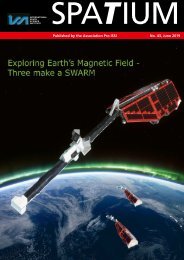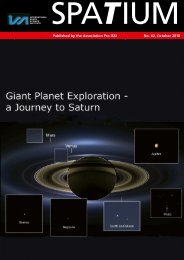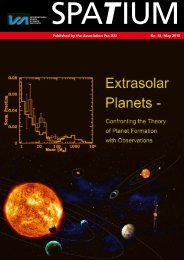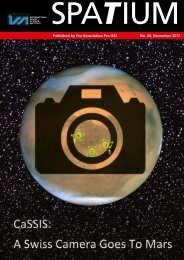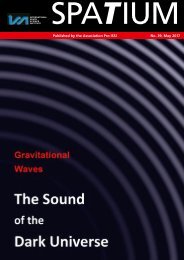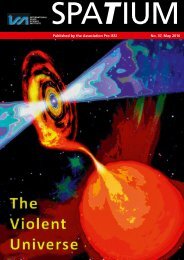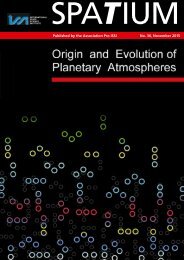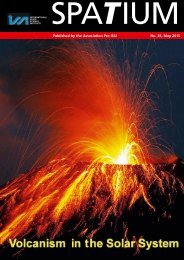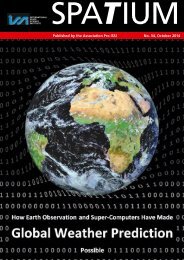Create successful ePaper yourself
Turn your PDF publications into a flip-book with our unique Google optimized e-Paper software.
INTERNATIONAL
SPACE
SCIENCE
INSTITUTE
SPATIUM
Published by the Association Pro ISSI No. 44, November 2019
Editorial
During lectures for the public and
for students, we sometimes provocatively
ask the audience to list
all possible forms of energy on
Earth – and to name their elementary
source. Of course, it is impossible
to find even the most exotic
appearance of any energy to be
other than of solar or stellar origin.
From time to time, it is just useful
for us all to remember how generously
we are fed with energy from
our life-giving star. Consequently,
the study of the Sun and its analogues
is one of the main quests in
astrophysics. However, there is still
much work on this side to be done.
As the high-energy part of the solar
radiation is blocked by the terrestrial
atmosphere, going to space is
crucial for observations in this
wavelength range. Various missions
have collected valuable data
to help us understand the processes
and learn how our power station
works. Still, so many things are as
yet not known:
How exactly is the energy generated
in nuclear reactions in the core
that is driving the solar dynamo
distributed far out into the solar atmosphere?
The solar magnetic field
plays a key role in this. It acts on
all scales, from the dynamo and its
roughly 11-year cycle down to the
most tiny and fractal structures.
Investigation and measurement of
the solar magnetic features is not
easy. However, the Sun is not the
only star we can observe; there
are more players in this league
of “cool stars”. With recent missions
observing other stars and
their companions (meaning Earth’s
extra-solar-system colleagues, the
exoplanets), we hope to gain more
information using a wealth of
statistics. This field of solar and
stellar research is within the expertise
of Dr. Karel Schrijver who
skilfully guided his audience along
measured and simulated magnetic
field lines during a proISSI lecture
in May 2019.
His presentation is the basis for the
current Spatium. Once more, the
editor is grateful to Prof. Martin
Huber and Dr. Andreas Verdun for
careful reading of the manuscript.
Anuschka Pauluhn
Mönthal, November 2019
Impressum
ISSN 2297–5888 (Print)
ISSN 2297–590X (Online)
Spatium
Published by the
Association Pro ISSI
Association Pro ISSI
Hallerstrasse 6, CH-3012 Bern
Phone +41 (0)31 631 48 96
see
www.issibern.ch/pro-issi.html
for the whole Spatium series
President
Prof. Adrian Jäggi,
University of Bern
Editor
Dr. Anuschka Pauluhn
CH-5237 Mönthal
Printing
Stämpf li AG
CH-3001 Bern
Title Caption
On 5 and 6 June 2012, the AIA
Atmospheric Imaging Array (AIA)
instrument aboard the Solar Dynamics
Observatory (SDO) observed a rare
transit of Venus. The image (taken in
the 171 Å channel, showing the solar
coronal glow from gases at temperatures
near 1 million Kelvin) is a composite
of slices, put together to show
the track of Venus across the Sun.
Credit: NASA/GSFC visualization
studio.
SPATIUM 44 2
Solar magnetic activity, with lessons
from stars and exoplanets *
by Karel Schrijver, Johannes Geiss Fellow, International Space Science Institute, Bern, Switzerland
The Sun’s
mysteries
Our Sun became more mysterious
when the first telescopes were
pointed at it early in the 17th century:
the Sun was found not to be
the immaculate sphere of predominant
supposition, but was instead
seen to display dark spots on its surface
(Figure 1). Not only did these
spots serve as markers revealing
that the Sun is a rotating body, they
also changed in appearance themselves
within a matter of days demonstrating
their transient nature,
although what that nature really
was remained a puzzle for a long
time. Over the following centuries
it became clear that the number of
sunspots waxes and wanes in a
quasi-regular 11-year cycle, that
their appearance shifts in latitude
through this cycle (Figure 2), and
that the Sun’s outer layers are rotating
differentially such that the
equatorial spin period is shorter
than the polar spin period
(Figure 5).
Sun was primarily made of hydrogen
and helium, while physicists
worked out the details of what that
implied: the Sun’s core is a vast fusion
reactor, primarily converting
hydrogen into helium.
Once spectroscopy, the method to
analyse light, was sufficiently developed,
more mysteries arose:
how does the Sun create its everchanging
magnetic field, and why
are sunspots the sites of the strongest
concentrations of that field?
How can it be that the Sun’s outermost
atmospheric layers are up to
a thousand times hotter than its
surface? We now know the foundations
of the answers to these and
many other questions about the
Sun, but much work remains to refine
them.
Why are astrophysicists so interested
in the puzzles of the Sun?
One reason is that it is a fascinating
and beautiful, ever-changing
object that begs to be observed and
understood. As it is by far the nearest
star, what we learn about the
Sun guides our thinking about
what happens in, on, and around
most other stars in the Universe.
Another reason is that we have
realised that the Sun’s variability
often influences our technological
infrastructures. This happens both
high up in space and around ground
level, through what has become
known as space weather. In this
article, I will take you on a tour of
some of the things we learned
about the Sun’s magnetism, and
how we continue to do so.
Figure 1: One of the earliest sunspot drawings, made by Galileo Galilei on 24 June
1612. Galileo had modified the design of the astronomical telescope, invented
around 1609, to image the Sun on paper, and then drew the visible sunspots. That
sunspots have a magnetic nature was discovered by George Ellery Hale in 1908.
The Sun’s mysteries deepened once
the quantitative tools of physics
were developed to determine the
age of the Earth: how had the Sun
maintained its energy output for
some 4.5 billion years? The answer
to that question was developed in
the first half of the 20th century as
astronomers discovered that the
* This issue of Spatium is based on
a proISSI seminar held by
Dr. K. Schrijver on 8 May 2019.
SPATIUM 44 3
One among
the stars
Although often described as an
average star, the Sun is not of
average size, mass or brightness.
The intrinsic brightness of stars
ranges from supergiants that are
tens of thousands of times brighter
than the Sun down to red dwarf
stars that are a thousand times
fainter (Figure 3).
The number of stars that form
throughout the Galaxy increases
smoothly as we look from heavy to
lighter stars. Those that form as
less-massive stars have longer life
spans: whereas heavy stars survive
for only a few million years, the
lightest can continue to fuse hydrogen
for hundreds of billions of
years. One result of these trends in
formation frequency and lifetime
as a function of stellar mass is that
the Sun is surrounded by mostly
smaller peers: our star is the fourth
largest, heaviest, and brightest
among the 50 stars in the solar
neighbourhood.
Figure 2: Top: The butterfly diagram, plotting the latitudes at which sunspots appear versus time.
The colouration indicates the fraction of the solar surface covered by sunspots. The first such diagram
was made by Walter and Annie Maunder in 1904. Bottom: Total sunspot area over time
and the numbering of the sunspot cycles. Sunspot records go back to the early 17th century, see,
e.g., http://sidc.oma.be/silso/. Credit: David Hathaway, NASA.
Although on the larger side of average,
the Sun by no means stands
out as unusual otherwise. It has an
average mix of chemical elements
and is halfway in its lifetime of
about 10 billion years as a mature
star. Even in its companions it is
not unusual: roughly every second
star that we see in the sky is single
like the Sun; the others are either
pairs of stars orbiting each other or,
ever less frequently, triplets, quadruplets,
or even larger multiples.
We have learned over just the past
quarter-century that even having
a planetary system is normal for a
star: the majority of the very
roughly 100 billion stars in the
Milky Way galaxy have at least one
exoplanet in orbit around them.
Most of these orbit a magnetically
active star, in many ways comparable
to our Sun.
SPATIUM 44 4
Figure 3: The Hertzprung-Russell diagram displays the
luminosities of stars as a function of their surface temperatures.
Mature stars, spending most of their lifetime
fusing hydrogen into helium, lie on the diagonal branch,
the so-called main sequence. When their fuel begins to
run out, they leave the main sequence to become giant
red stars. The more massive ones become giant red stars.
Once a star like the Sun has consumed all of its fuel, it
evolves into a compact white dwarf, a glowing stellar
ember the size of the Earth. The bubbles indicate relative
sizes of stars, but in reality the contrast is much
larger: supergiant stars can be hundreds of times larger
than the Sun, while white dwarfs are a hundred times
smaller. Credit: ESO.
Listening to
the Sun
For half a century now, astrophysicists
have been recording sound
waves to probe the interior of the
Sun. The waves are generated as
a byproduct of the overturning
movements of the gas in the convective
envelope of the Sun, most
readily in the near-surface layers.
The pressure fluctuations propagate
through the interior of the
Sun with little dampening. When
they propagate into the solar interior,
their paths are bent back towards
the surface as a result of the
increasing temperature and the
associated increase in propagation
speed. When they reach the solar
surface, those with a period exceeding
a few minutes are reflected.
Together, these two effects
create a cavity within which resonant
interference develops into
millions of standing waves with
periods of around five minutes:
the Sun rings like a bell, but in a
multitude of tones simultaneous ly.
At the surface, these standing
waves can be detected in one of
two ways: (1) as intensity fluctuations,
owing to compressions and
rarefactions by the waves, and (2)
as Doppler shifts, owing to the
undulating motions. Modes with
high degrees (with many nodes
across a surface at constant radius)
probe, primarily, the near-surface
layers, while low-degree (nearly
purely radial) modes probe much
of the solar interior. Disentangling
the multitude of modes requires
precise and sustained observations,
measuring velocities of the order
of 20 cm/s from uninterrupted
measurements spanning several
months at least. The result is the
equivalent of a medical ultrasound
scan of the Sun’s internal structure
and – through Doppler effects on
the sound waves – of large-scale
subsurface wind patterns, referred
to as flows. This practice, known
as helioseismology, has helped in
many distinct ways to better understand
the Sun and, with that,
other stars: it has validated stellar
structural models, established the
age of the Sun, and even guided
particle physicists to new realisations
about the processes by which
neutrinos of one type can turn into
another.
Figure 4: The internal structure of the Sun. Energy is released by nuclear
fusion in the core, moves in a scattering exchange with ionised
matter through the surrounding radiative zone, until overturning convective
motions become the dominant transport process in the outer
envelope. From the Sun’s surface outward, the gas is essentially transparent
to the bulk of the light, but special filters and telescopes can
show the structures in the outer regimes of the chromosphere (around
20 000 degrees) and the corona (above a million degrees). Credit:
NASA.
SPATIUM 44 5
The Sun’s
interior
Helioseismology has led to a detailed
knowledge of the stratification
of density and temperature
throughout the Sun (Figure 4). It
confirmed that the Sun’s deep
interior, although entirely gaseous,
is rotating at the same angular rate
throughout, thus spinning just like
a solid body. Energy is transported
outward from the nuclear reactions
in the core by a random walk of
photons. These frequently exchange
energy with ions and electrons
as they scatter between them.
Until, that is, they reach a layer on
their way around the solar interior
in which the temperature is
sufficiently low for a substantial
number of neutral atoms to exist
in the mix. At that point, some
200 000 km below the surface, the
opacity of the gas increases and
energy transport in the form of
electromagnetic radiation becomes
impeded. There, another mode of
energy transport begins to dominate:
convective overturning motions
carry thermal energy upward
until ultimately, about 700 000 km
from the centre, radiation can
freely escape into space from the
solar photosphere, the layer with a
thickness of some 100 km that we
experience as the solar surface.
The rotation of the Sun, once
every 25 days on average, leads to
Coriolis forces acting on the convective
motions, as they do on
Earth, for example, in low and
high-pressure areas in the troposphere.
Helioseismology has revealed
that rotation and convection
set up large-scale winds throughout
the convective envelope. The
equatorial zones rotate faster than
the high-latitude zones, in such a
way that the Sun’s rotation rate is
mostly constant with depth along
a radial line through the envelope,
but that it is decreasing with increasing
latitude (as shown on the
right in Figure 5). In addition to this
azimuthal (east-west) motion there
is also a meridional (north-south)
pattern. It is most readily seen at
the surface as an equator-to-pole
flow reaching a maximum of about
15 m/s at mid-latitudes. The return
flow at depth is still being investigated:
the denser interior
counterflow is much slower and
therefore harder to measure. It remains
unclear whether there is
only one global overturning motion
like a giant conveyor belt (as
depicted on the left in Figure 5) or
whether circulations are layered,
possibly two or three cells deep,
within the envelope.
Figure 5: Illustration of the components
of the largest-scale flows within
and somewhat below the solar convective
envelope as revealed by helioseismology.
Right side: the Sun’s latitude-dependent
rotation within the
convective envelope morphs into a
near-rigid rotation deeper down. Left
side: the meridional circulation, here
shown with a single overturning cell for
each hemisphere, is poleward near the
surface and equatorward at depth. This
flow is so slow, deep down, that its actual
pattern is yet to be determined.
Credit: NASA.
SPATIUM 44 6
Figure 6: A map (magnetogram) of the magnetic field of
active region AR 12192, observed by the Solar Dynamics
Observatory (SDO), showing the two opposite magnetic polarities
in blue and yellow. The coronal magnetic field above
the surface is visualised through the bright, thin coronal loops
in the slightly-sharpened EUV (171 Å channel) image blended
on top.
For comparison, another SDO EUV (193 Å) image of the
same site is shown with field lines computed assuming there
are no electrical currents above the surface. The mismatch of
the pattern of the observed loops with that of the model field
shows that strong electrical currents exist above this region.
Such currents contain energy that can be released in a solar
flare, coronal mass ejection, or both. Credit: SDO/AIA team
at Lockheed Martin Solar and Astrophysics Lab, and NASA.
The magnetic
Sun
It took decades of observations, but
we now know that all stars that
generate a dynamic magnetic field
like that of the Sun have one thing
in common: they all have a convective
envelope around an essentially
stationary (although spinning)
interior. All such stars have
surface temperatures on the cool
end of the stellar range, and they
are therefore commonly known
as “cool” stars. Their relatively low
surface temperature makes them
appear yellow, orange, or red, and
places them on the righthand side
of a diagram commonly used by
astrophysicists, the so-called
Hertzsprung-Russell (or HR) diagramme
(Figure 3).
The magnetic phenomenon that
was first discovered is that of the
sunspot (Figure 1). We have known
these to be clusters of intense
magnetic field since spectroscopic
measurements were developed to
demonstrate that in 1908, but their
behaviour had been studied for
almost three centuries before then.
Sunspots are temporary structures,
surviving for days or at most about
two weeks. Their overall numbers
wax and wane on a quasi-regular
11-year time scale in what is known
as the sunspot cycle (bottom panel
of Figure 2). In each cycle, successive
generations of sunspots emerge
from the interior, first at mid-latitudes,
then the band of emergence
shifts towards lower latitudes, and
as one cycle fades away near the
equator, another begins at midlatitudes
(upper panel in Figure 2).
Sunspots are part of so-called
“ active” regions that result from
the emergence of a bundle of magnetic
field from the interior. As the
arched bundle breaches the solar
surface, pairs of adjacent patches of
opposite magnetic polarity form
(see the blue-yellow background
image in the left panel of Figure 6).
Sunspots commonly form within
the regions with large magnetic
fluxes. The sizes of bipolar regions
range from the largest at some
200 000 km across down to the observational
limit of magnetographs
around a few thousand kilometres,
with the number of regions rapidly
rising as sizes decrease. Active regions
are by definition bipolar
regions large enough to have sunspots
at some time in their lives.
Roughly one out of every two such
regions emerges close to the site
of previous active regions, often
while the previous active region
SPATIUM 44 7
still persists at that location. This is
referred to as a sunspot nest.
Some days to a week after emergence,
after a phase of moderate
coherence, the bipolar regions are
shredded into fragments by the
turbulent convection. The fragments
begin a meandering random
walk superposed on the large-scale
flows of differential rotation and
meridional advection. As they do
so, they often collide with other
such parcels of magnetic flux. If of
equal polarity, a larger conglomerate
of flux temporarily forms. If of
opposite polarities, fluxes cancel,
in the process removing equal
amounts of oppositely signed flux
until the smaller of the two disappears.
This cancellation works in
time series of magnetic-field maps
almost as an arithmetic summation
of signed fluxes. In reality, on the
Sun, the physics involves reconnection
of magnetic field, followed
by either retraction or expulsion of
the newly connected arches from
the surface layers. The multitude
of small bipolar regions, the socalled
ephemeral regions, play an
important role in this. They maintain
the small-scale mixture of
opposite polarities of much of the
solar surface, the so-called “quiet”
(i.e., not belonging to an active
region) Sun, and is there the foundation
of the faint and relativelycool
quiet corona. The cancellation
and replenishment processes
of ephemeral regions with other
flux help maintain a smaller-scale
population which more readily
disperses stochastically. Consequently,
the outcome of this magneto-chemistry
of clustering and
cancellation is a patchwork of pepper-and-salt
polarities, mixed on a
range of scales. All this aids in the
dispersal of flux as well as in the
heating of the atmosphere through
the frequent reconnection of field
driven by the motions below.
Figure 7: The multi-temperature solar
atmosphere: a composite of images by
the SDO telescopes. From right to left:
the visible-light solar surface; 1600 Å
image of the high surface layers and in
part the transition region to the hot corona;
He II 304 Å of the high chromosphere;
and a three-channel composite
of the corona (171 Å, 193 Å, and 211 Å)
with blue, green, red roughly corresponding
to 1 MK, 1.5 MK, and (2 to
3) MK. Credit: SDO/AIA team at
the Lockheed Martin Solar and Astrophysics
Lab.
Figure 8: A segment of the Sun’s chromosphere. This domain immediately above
the solar surface can be seen only in a few specific colours emitted by some of the
dominant chemical elements. In this case, the images are taken in light of nonionised
hydrogen (Hα). Hot, ionised material can only move along the magnetic
field. Frequent collisions between neutral atoms and ions enforce largely joint
motions. As a consequence, this image of the neutral gas reveals the structure of
the magnetic field, such as the near-vertical fibrils that extend from a sunspot region
underneath. They appear clipped at the top where the temperature shoots up to a
million degrees or more so that neutral hydrogen disappears as it is ionised. A nearly
horizontal set of fibrils outlines a twisted field structure, here forming a small
current-carrying filament. Credit: Swedish Solar Telescope team.
SPATIUM 44 8
Dynamos in
cool stars
Observations of stars have revealed
that all cool stars display signatures
of magnetic activity, typically
more pronounced for more rapidly
rotating stars. From that we learned
that convection and rotation (and
thus the Coriolis force) are key to
stellar dynamos.
Although the primary ingredients
of solar-like stellar magnetic activity
are known – rotation and a convective
envelope reaching up to the
stellar surface – there is no comprehensive
first-principles dynamo
theory. We do not know why the
Sun is as active as it is although it
is compatible in its activity with
other cool stars of comparable
spectral type and spin rate. We do
not understand why the Sun has a
pronounced yet somewhat unsteady
11-year cycle. In fact, we are
realising that cycling stars are in
the minority among the cool stars,
while among the really Sun-like
stars of comparable rotation rate,
the Sun appears to be the only one
with a clear activity cycle. That
latter point needs further study
because the number of such stars
that have been monitored for their
activity over many years is rather
lower than what we would need
for a firm conclusion.
Figure 9: A massive explosion rocked the Sun on 7 June 2011, lifting an enormous
amount of cool, dark, EUV-absorbing material into the high corona. The event is
shown here (with the solar rotation axis moved by about 120 ° counterclockwise)
in a combination of three false-colour SDO images with blue, green, and red for
temperatures around 1 MK, 1.5 MK, and (2 to 3) MK, respectively. Most of the
cooler material eventually fell back onto the Sun, heating up to a million degrees
or more on impact from the gravitational energy of the fall. This is expected to
resemble what happens when forming stars capture gas from their surroundings.
Credit: SDO/AIA team at LMSAL, and NASA.
Despite this ongoing puzzle about
stellar dynamos, numerical models
are helping to rapidly advance our
insights. The interaction between
magnetic field and convective motions
mediated by the magnetic
Lorentz force is ever more realistically
included and studied down
to increasingly smaller scales. The
tremendous density contrast between
the bottom and top of the
convective envelope, and the attendant
enormous scale difference
of the convective motions (from
50 000 km to 50 km) that needs to
be included in models, is covered
increasingly well as computers become
more powerful.
Understanding why and where
flux bundles form as the origin of
bipolar regions (including the persistence
of sunspot nests) remains a
challenge. The same is true for
understanding how certain flux
bundles can reach the surface as
such coherent and strong structures
as they are. It is in these surface
layers where observations show
that convection shreds the flux
bundles, and where thermal radiation
suddenly has a freely available
escape route out of the Sun in
contrast to their confinement in
the dense, opaque layers below.
Most state-of-the-art dynamo
models are still restricted to the
deeper layers, leaving the last few
per cent of the solar radius untouched.
Flux-emergence models
that show how the field may behave
in those near-surface layers
typically start with a ready-made
SPATIUM 44 9
flux tube that is introduced into,
or even simply released from, the
bottom end of such limited- volume
models that reach just a few percent
(tens of thousands of kilometres)
into the Sun.
Because of these numerical challenges,
closing the life cycle of field
(from formation in the deep envelope,
through transport to and
across the surface, to ultimate retraction
upon cancellation to seed
the next cycle) remains beyond our
capabilities even in the most advanced
radiative magneto-convective
codes. To bridge this gap, researchers
work on innovative
combinations of magneto-convective
modelling for the deeper interior
linked to empirically-guided,
highly-simplified flux transport
across the surface. These modelling
combinations appear to be a
promising avenue of research for
limited-time cycle forecasting, but
they are only temporary stepping
stones towards understanding of
dynamos in cool stars in general.
Cool spots,
hot faculae
The magnetic field in sunspots is
strong enough to impede convection
near the surface. With less heat
being supplied from below, the
temperature inside the fields settles
to a lower equilibrium, and the gas
to a lower brightness, than in the
surrounding area. This leads to
cool, dark spot cores. This also
causes the photosphere, the apparent
solar surface, inside the spot to
lie below its surroundings because
the gas density falls off more rapidly
at the lower temperature.
Light leaks in sideways providing
energy to the interior, but for the
large flux bundles that make sunspots,
the cooling area of the spot
interior is too large to maintain the
gas there at temperatures similar to
those of the surrounding solar surface.
In contrast, for slender flux
bundles, which have only somewhat
smaller intrinsic field
strengths at the surface, radiation
leaks in sideways in much greater
proportion to the cooling interior.
Thus, a slender tube can maintain
an internal temperature and brightness
similar to the values of the
gases in its vicinity. For very slender
tubes the photosphere also lies
below that of their surroundings.
Here we can even peak into deeper,
hotter, brighter layers. These form
the so-called faculae, small bright
patches, the ensemble of which results
in much of the visible brightening
of the active region. The effect
of the multitude of slender flux
tubes with some sunspots dotting
the solar surface is that at cycle
maximum the Sun appears brighter
by a few tenths of one per cent,
while sunspots then cause temporary
dips in the solar irradiance as
they cross near the central
meridian.
Figure 10: Visualisations of the magnetic field over active region AR10930 before (left) and after (right) a large flare, shown
against the corresponding map of the vertical magnetic field at the surface. Sample field lines outline the field (coloured when
they reach outside the box). The red volumes show where the most intense electrical currents run. Much of the energy associated
with these currents was used to power the solar flare and eruption, leaving a much-weakened pattern after the event.
Figure 3 from Schrijver et al. (2008).
SPATIUM 44 10
The hot outer
atmosphere
Another puzzle begins just above
the solar surface. The first layer
following the photosphere is the
chromosphere, named after its red
glow from the prominent Hα-line
of the hydrogen spectrum that is
seen around the lunar limb during
total eclipses. It is mostly transparent
except in the strongest spectral
lines of common chemical elements.
This domain is hot enough
to be largely ionised, but atoms
will have typically lost only one or
two electrons at a gas temperature
that is some three to four times that
of the solar surface (which itself lies
around 5 800 K). Above that, at
heights of some 10 000 km and
above, lies the corona: that domain
reaches temperatures of typically
20 to 50 times that of the surface
and more, and radiates primarily
in the extreme ultraviolet (EUV)
and in soft X-rays. The corona is
visible to the unaided eye only
during total solar eclipses through
sunlight that is scattered off the free
electrons that it contains. Hydrogen
and helium, the dominant elements
anywhere in the Sun, are
fully ionised there and thus have
no contribution in the ensemble of
EUV and X-ray spectral lines. Elements
such as the fairly abundant
carbon, nitrogen, oxygen, and iron
retain some electrons even at million
degree temperatures, and they
consequently dominate the coronal
emission (Figure 7).
Figure 11: This visualisation is a side-view snapshot from a computer model of a
solar flare. The violet, red, and green represent temperatures below 1 MK, between
1 MK and 10 MK, and above 10 MK, respectively. The model extends vertically
from 10 000 km below the surface (a relatively cool and opaque domain shown in
black) to 40 000 km above the surface. In this model, a rising flux tube emerged
through the surface, destabilised, and erupted in a solar flare, with matter ejected,
some falling back, rising in temperature through resistive heating and then cooling
by radiation and conduction. After Cheung et al. (2019), from https://news.
ucar.edu/132648/emergence-eruption.
In most of the solar corona, and in
much of the solar chromosphere,
the energy density in the magnetic
field outweighs that in the thermal
motions of the ions and – if present
– neutral atoms. Therefore, it is the
magnetic field that prescribes the
shape of atmospheric structures:
ions and electrons can move along,
but not perpendicular to, the magnetic
field. This results in essentially
linear atmospheric structures
that move with the field as that responds
to flows at the surface and
below. Collisions between ions and
neutral atoms at these heights also
cause the neutrals to be dragged
along. The result is an atmosphere
in which emitting and absorbing
clouds outline the magnetic field
(Figures 6, 7, and 8).
Ever since the late 1940s, when
scientists realised just how hot the
corona is, the processes that heat
the outer atmosphere of our star
have been the subject of research.
This remains a challenge, although
it has shifted in nature. There is so
little gas in the atmosphere of the
Sun that it takes only a minute
fraction of the Sun’s energy budget
to keep it hot. The problem is not
the amount of energy, but how that
is delivered in the right form to
create the very high temperatures:
sunlight, no matter how much
energy it contains, cannot do that
because it cannot raise a temperature
above its own characteristic
equivalent of 5 800 K.
At first, sound waves were thought
responsible, and solutions were
sought for hot coronal structures
stable enough to persist for many
hours. These had been inferred
from the low-resolution and lowcadence
observations in the early
days of space science. Now, we re-
SPATIUM 44 11
as a consequence of how field is
injected and transported across the
surface.
Figure 12: Solar eruptions can cause perturbations to rock much of the outer atmosphere, sometimes
right across the Sun, such as in this case for a flare from AR 12673 (on the limb, at lower
right). Left: False-colour composite of the solar corona, about 5 minutes before the flare reached
peak brightness, combining channels 211 Å (red, most sensitive to gases at about (2 to 3) million
degrees), 193 Å (green, characteristic of about 1.5 MK), and 171 Å (blue, peaking around 1 MK).
It shows the erupting flux rope and identifies active regions and other features. Right: This panel
shows only what is still changing 45 minutes after the eruption started: neutral grey is unchanging
while bright (or dark) grey means overall brightening (or dimming). Changes in colour indicate
plasma heating when yellow or red, or cooling when blue. The shock wave and other
perturbations have by then reached across much of the Sun (with a diameter of 1 400 000 km).
(Part of Figure 1 from Liu et al. (2018), which shows more snapshots over time.)
Computer experiments are also
rapidly advancing in fidelity in this
challenging area. Radiative exchange,
transient ionisation effects,
and ion-neutral interactions have
been demonstrated to be important
for the chromosphere. For the
corona, coupled cascades between
turbulently-driven electrical currents
and wave-mode couplings are
essential ingredients in the overall
process of heating solar and stellar
atmospheres.
Solar flares and
eruptions
alise that forms of energy suitable
for heating the solar atmosphere
have to do with the magnetic field:
dissipation of electrical currents
and magnetic waves, in some mixture
that likely depends on the environment,
lead to an ever-changing
cloudscape of atmospheric
features evolving on time scales of
the order of tens of minutes.
Whatever the processes are in detail,
we now know they happen
similarly in all cool stars: there is a
basal chromospheric level of heating
that is likely related to acoustic
waves and maybe also to a
small-scale turbulent dynamo, but
beyond that the magnetic phenomena
of all cool stars behave comparably
in heating their atmospheres.
In fact, once the radiative loss in
one activity diagnostic is measured,
all others can be estimated
with fair accuracy using power-law
relationships. The existence of such
power laws hints at self-similarities
in the processes 1 , regardless of surface
gravity or convective properties.
For the Sun and Sun-like stars,
power-law relationships valid on
the scale of active regions transform
into similar ones for stars as
a whole, at different activity levels
The magnetic bundles that breach
the solar surface to form active regions
often carry strong electrical
currents. Such currents can also be
the result of the movements of the
field that are forced by (sub-)surface
convection, by the interaction
with neighbouring regions, or
with intruding flux bundles (as in
sunspot nests). The currents reflect
stresses in the field; these may be
relaxed through instabilities, that
at least change the field geometry
(and may thus not require electrical
resistivity), but generally also its
topology (requiring magnetic reconnection,
and thus resistivity).
1
In fact, the self similarity or scale invariance is the most prominent feature of a power law: if the argument of the
function f(x) = a x p is multiplied (scaled) by a factor c, f(cx) = a(cx) p = ac p x p = Cf(x), the result is proportional to the
original function. The process looks similar on all scales.
SPATIUM 44 12
The instabilities that occur in these
fields lead to explosive energy
transformations from magnetic
energy to energy of motion. This
commonly results in energy budgets
of comparable order of magnitude
for heat (and its cooling
radiation), energetic particles (most
Figure 13: Number of flares per year (averaged over
the solar cycle) that exceed a total radiated (bolo metric)
energy E bol . The green dashed line is a fit to solar data
connecting feeble EUV network flares and powerful
active-region X-ray flares, with X-ray flare data shown
separately by the grey line. A horizontal dotted line
marks the detection limit for space-based solar observations.
The grey area identifies the uncertainty that
currently exists for extreme solar events: straight down
if extremely energetic flares do not occur on the Sun,
or curving more slowly if they do. Frequencies of stellar
flares observed with the Kepler satellite for Sunlike
stars at about solar rotation rates are shown by diamonds;
they suggest that extreme solar flares should
be anticipated to occur infrequently. Maximum flare
energies reported for all magnetically-active stars and
for truly Sun-like stars are indicated by vertical lines.
The X/EUV flare frequencies for the stars κ Cet and
EK Dra, Sun-like but spinning much faster, are shown
for reference, normalised downward to the frequency
expected for a Sun-like star as inferred from Kepler
data. From Schrijver and Beer (2014).
of which deposit their energy lower
in the atmosphere, there creating
the flare ribbons at the foundations
of the most recently reconnected
magnetic field), and bulk outward
motion. The latter involves eruptions,
many of which propagate
into the heliosphere as coronal
mass ejections (CMEs), particularly
frequently for the most energetic
events.
The instabilities leading to eruptive
and explosive phenomena
(Figure 9) result from the sudden
conversion of magnetic energy
into other forms (Figure 10). This
appears to be associated with the
onset of accelerated reconnection;
arguments about whether that is
the cause or the consequence of the
energetic events continue. What
has become clear, though, is that
the instability can occur because of
different conditions. Magnetic
flux may already be so strongly
stressed upon breaching the solar
surface that, for example, a kink
instability (as happens in twisted
rubber bands and garden hoses) is
unavoidable. Other ways to destabilise
the field and to release the
energy stored in the magnetic field
are by emerging new flux moving
into pre-existing configurations or
through (sub-)surface flows that
stress the field. Yet another pathway
to instability is that the surrounding
field may change so that
its s tabilising influence is reduced.
Observations show that all of these
cases occur. Machine learning has
reached a state that its predictive
skills are comparable to those of
observers with years of experience.
Now we need to learn what the
computers have picked up on.
Model calculations (such as the
magnetic field shown in Figure 10,
computed from vector-magnetic
maps before and after a flare and
eruption) are being used to understand
how we can differentiate
these cases and predict the outcome.
The most challenging cases
are comprehensive flux-emergence
models that can take flux
bundles from deep within the virtual
Sun into the atmosphere, to
simulate eruptions and their geometry
there (Figure 11).
In recent years, we have realised
that the large eruptions that form
coronal mass ejections are part of
a continuum of ever more frequent
eruptions as we look towards
smaller scales: for example, with
size expressed as a heliocentric
opening angle, the frequency of
eruptions from multitudes of small
bipoles of some 10 000 km across
to the rare million-kilometre filament
eruptions form a continuous,
smoothly-decreasing distribution.
With access to X-ray, (E)UV, and
visible-light images, we are seeing
that the flare ribbons of high-energy
active-region eruptions have
EUV counterparts in large quiet-
Sun eruptions: there may be a shift
towards lower energies across the
colour spectrum as we look towards
weaker-field settings, but
the basic phenomena related to the
post-eruption reformation of ruptured
arcades of magnetic field appear
similar. SDO observations of
the full Earth-facing side of the
Sun, supplemented by far-side images
from the STEREO spacecraft,
revealed the long-range connections
in the Sun’s magnetic field:
smooth reconfigurations or sudden
SPATIUM 44 13
shock waves from one region can
travel far (Figure 12) and may trigger
destabilisation in others, sometimes
at large distances. Studies of
ensembles of flares and eruptions
over multiple years showed that
our thinking needed correction:
where long-duration flares were
thought to be those involved in
CMEs, new analyses show the distinction
to lie in the scale of the
destabilising field, not in whether
a CME formed or not: larger structures
simply tend to take longer to
evolve. Computer models help us
interpret these aspects.
Figure 14: Principles of transit spectroscopy. As an exoplanet
transits a magnetically active star, it provides
information on the limb-darkening of the stellar surface
and on possible active-region and spot features.
The starlight propagating through the planetary atmosphere
provides information on the chemical makeup
and stratification of that atmosphere. Entering and exiting
from the secondary eclipse, when the exoplanet
moves behind the star, reflected and scattered light
from the exoplanet may be most readily separated from
the starlight to extract spectral signatures of the atmosphere.
The stellar and planetary signals can in principle
be separated by studying a variety of ionic, atomic,
and molecular lines across much of the colour spectrum
throughout the transit.
Of stars, ice,
and trees
The variable output in sunlight,
solar energetic particles, and magnetised
solar wind affects all bodies
that orbit the Sun. For Earth,
this collective of phenomena
driven by solar magnetic variability
is known as space weather. Its
effects are by no means limited to
space: aspects of space weather include
interruptions in radio communications,
malfunctions of satellites,
noise on navigation and
positioning signals, harm to astronaut
health, variations in the quality
of electric power, and even catastrophic
loss of large transformers
triggering regional electricity
blackouts.
Observations of the Sun and of
Sun-like stars have greatly advanced
our knowledge of the processes
that drive space weather as
well as constrained their statistical
likelihoods. One thing remains a
major challenge, though: establishing
the worst-case scenario. Many
frequency distributions of various
aspects of solar activity exhibit
power-law distributions, smoothly
connecting the frequent, weak
events to the rare, most-powerful
events (Figure 13). But the most extreme
drivers of space weather may
not be the once-in-a-century
events that we have observed to
date. Stars like the Sun have been
seen to flare with energies at magnitudes
exceeding hundredfold the
largest directly-observed event on
the Sun. However, for stars of solar
age and mass, such superflares
are rare indeed, occurring perhaps
once in a million years. It is the
events of intermediate energies
that may happen once every 1 000
or 10 000 years that we need to
worry about: they could have disastrous
impacts on our technologyreliant
society.
Monitoring of many thousands of
cool stars for years on end, as done
by the Kepler satellite while it
hunted for exoplanets, also provided
a treasure trove of information
about stellar magnetic activity
and the occurrence of extreme
flares on stars like the Sun. The
statistics are still insufficient:
single, solar-age, Sun-like stars of
roughly solar rotation period appear
to be able to generate infrequent
superflares, but neither the
flare frequency nor the full characteristics
of the superflaring stars
have been sufficiently elucidated,
so uncertainty remains (shown by
the grey area in Figure 13). Hunts
for radio-nuclide signatures in natural
terrestrial records (in ice sheets
and tree rings) and in lunar rocks
(working as dosimeters on the
lunar surface) suggest that at least
energetic-particle storms have not
exceeded historically-recorded
levels by much over the past millions
of years. Whether that means
the Sun does not generate more extreme
events than observed in the
space era, or whether there is some
limit to the energetic-particle population
separate from that of flare
impacts remains under study.
SPATIUM 44 14
Observatories,
models, and
transits
Fundamental questions of solar
magnetic activity involve plasmafield
interactions leading to, among
other things, astrophysical dynamo
processes and magnetic instabilities.
These are also fundamental
to understanding the formation of
stars and planetary systems, and the
habitability of exoplanets. Because
of that, we can expect advances in
the adjacent fields of astrophysics
and planetary-system physics to
support advances in solar physics,
and vice versa. Observations of stars
are continuing from ground- and
space-based observatories. With
NASA’s Kepler satellite’s monitoring
mission terminated, new generations
of instruments are coming.
Among them, NASA’s TESS
(Transiting Exoplanet Survey Satellite),
ESA’s Gaia, the upcoming
ESA/Swiss CHEOPS (CHaracterising
ExOPlanet Satellite), and
NASA’s JWST (James Webb Space
Telescope), for example, have the
potential of finding not only more
exoplanets and studying their atmospheres,
but also of gathering
more information on their host
stars and their dynamos (Figure 14).
But also in its own right, the future
of the field of solar magnetic activity
remains bright: in the virtual
world, computers are ever more
powerful, and their abilities for
high-fidelity modelling are rapidly
advancing; data mining techniques
are making use of growing observational
archives. Artificial intelligence
is speeding up what we
learn from observations and, presumably,
will soon do the same by
scanning ensembles of numerical
models. The most prolific spacebased
observatory yet to look at the
Sun, NASA’s Solar Dynamics Observatory,
remains functional after
almost a decade of continuous observing,
while high-resolution
spectroscopic observations of small
areas continue with NASA’s IRIS
(Interface Region Imaging Spectrograph)
and JAXA’s Hinode.
Further reading
For images of the current Sun, or any
other date during the SDO mission, see
http://suntoday.lmsal.com.
The journal “Living Reviews in Solar
Physics” provides freely accessible review
papers on a wide range of broad topics,
including those covered in this article.
See http://www.springer.com/
journal/41116.
Spatium No 2, von Steiger, R.,
Das neue Bild der Sonne, Nov. 1998.
Spatium No 8, Beer, J., Sun and
Climate, Nov. 2001.
Spatium No 17, Balogh, A., The
Helio sphere: Empire of the Sun,
Oct. 2006.
Spatium No 22, Parker, E., Solar Magnetism
– Discovery and Investigation,
Aug. 2008.
Benz, A.O., Flare observations, Living
Rev. Sol. Phys. 14:2., https://doi.
org/10.1007/s41116-016- 0004-3,
2017.
Cheung, M.C.M., Rempel, M.,
Chintzoglou, G., plus 11 authors,
A comprehensive three-dimensional
radiative magnetohydrodynamic
simulation of a solar flare, Nature
Astronomy, Volume 3, 160, 2019.
NASA’s Parker Solar Probe is exploring
the innermost heliosphere to
understand the solar wind and the
formation and propagation of energetic
particles. Among the
ground-based observatories is
NSO’s new, large DKIST (Daniel
K. Inouye Solar Telescope) in Hawaii
that is nearing completion.
And ESA’s Solar Orbiter is about to
embark on the exploration of the
Sun from a close-in and out-ofecliptic
orbit. Our learning
continues …
Liu, W., Jin, M., Downs, C., plus 3
authors, A Truly Global Extreme
Ultraviolet Wave from the SOL2017-
09-10 X8.2+ Solar Flare-Coronal
Mass Ejection, ApJL 864, L24, 2018.
Schrijver, K., One of ten billion
Earths: How we learn about our
planet’s past and future from distant
exoplanets, Oxford University Press,
2018.
Schrijver, C.J. and Beer, J., Space
Weather From Explosions on the Sun:
How Bad Could It Be?, EOS: Transactions
AGU 95(24), 201, DOI:
10.1002/2014EO240001, 2014.
Schrijver, C.J., Beer, J., Baltensperger,
U., plus 9 authors, Estimating the
frequency of extremely energetic solar
events, based on solar, stellar, lunar,
and terrestrial records, JGR (Space
Physics), DOI:
10.1029/2012ja017706R, 2012.
Schrijver, C.J., DeRosa, M.L.,
Metcalf,T., plus 14 authors, Nonlinear
force-free field modeling of a
solar active region around the time of
a major flare and coronal mass ejection,
Astrophysical Journal 675, 1637,
2008.
SPATIUM 44 15
SPATIUM
The Author
Karel Schrijver is a stellar astrophysicist
and writer specialising in
the study of the Sun and the space
around it, stellar magnetism and its
impacts on the environments of
planets, and the science of space
weather. He received his doctorate
in 1986 at the University of Utrecht,
the Netherlands, on the
topic of solar and stellar magnetic
activity. After postdoctoral appointments
at the University of
Colorado and the European Space
Agency, and a fellowship of the
Royal Netherlands Academy of
Sciences, he joined the Lockheed
Martin Advanced Technology
Center where he eventually became
a Senior Fellow. He was lead
scientist and Principal Investigator
for two of NASA's scientific spacecraft
studying the Sun: the Transition
Region and Coronal Explorer
(TRACE) and the Atmospheric
Imaging Assembly (AIA) on board
the Solar Dynamics Observatory
(SDO). He has published over 260
research publications and articles.
Karel's interests include disseminating
newly developed understanding
of our neighbouring star
and its influence on society to
students and the public. For two
three-year terms, he served as dean
for the NASA Heliophysics Summer
School that resulted in a
5- volume book series on heliophysics
as an integrated science for
which he was the lead editor. He
co-authored the first textbook on
“Solar and Stellar Magnetic Activity”,
and recently completed a textbook
on the “Principles of heliophysics” for
advanced undergraduate students
and beginning graduate students.
Lately, he has been working on
popular science books, publishing
“Living with the stars” (2015) on the
multitude of connections between
the human body, the Earth, the
planets, and the stars, and “One of
ten billion Earths” (2018) about exoplanetary
systems in general and
how we learn about our own planet's
past and future from distant exoplanets
in particular.
He has served in multiple NASA
advisory functions, was a member
of the Space Studies Board of the
National Research Council, and
chaired the Road Map Panel for
Space Weather Science for the International
Council for Science’s
Committee on Space Research
(COSPAR).
He has been appointed ISSI's
Johannes Geiss Fellow 2018.



